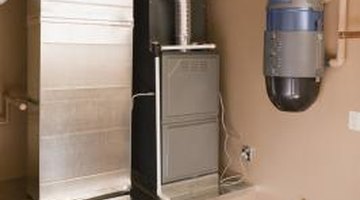Gas Furnace Vent Pipe Types
Using the correct piping materials with your gas furnace is more important than you may realize. As gas is burned, it produces fumes inside the heat exchanger compartment of your furnace that contain carbon monoxide, which is a highly toxic gas. The type of furnace you have and its age determine which type of piping material to use for proper ventilation. Pipes should be inspected annually for leaks and cracks to keep your home safe and as energy efficient as possible.
PVC

PVC pipes are used on conventional and sealed combustion high-efficiency furnaces. This is because their combustion process produces and exhausts gases and condensate at a rapid pace, which would corrode metal materials in a short time. The PVC vent pipe connects to a PVC flue pipe at the top of the furnace unit. An electric-powered fan forces the exhaust gas from the furnace chamber into the PVC flue pipe and drives the exhaust gases outdoors. All high-efficiency furnaces are direct exhaust systems and eliminate the need for pipes that connect to a conventional chimney flue. High-efficiency furnaces have efficiency ratings of about 95 percent, according to the Department of Energy and the Environmental Protection Agency, which is the highest rating for residential furnaces. PVC pipes used on sealed combustion high-efficiency furnaces draw air from the outdoors through PVC pipes, instead of air from the indoors, which is the case with conventional high-efficiency furnaces. As a result, the sealed combustion ventilation process reduces draftiness in rooms because indoor air is not circulating and mixing with heated air.
ABS
Acrylonitrile Butadiene Styrene (called ABS) is a rigid plastic pipe alternative to PVC. Like PVC, ABS pipes are used for high-efficiency furnace ventilation systems. You can distinguish an ABS pipe from PVC by its color, as ABS is black and PVC is white. Like PVC, ABS does not rust, corrode or collect condensate, which makes it a good material for direct vent furnace systems. However, some HVAC professionals view ABS as lighter and more apt to crack in comparison to PVC.
CPVC
Chlorinated Polyvinyl Chloride (called CPVC) is a thermoplastic pipe and fitting material. It is a second alternative to traditional PVC piping for furnaces. Like PVC and ABS, CPVC is only used for high-efficiency furnaces. As a synthetic piping material, CPVC is more heat-tolerant than PVC and ABS. CPVC can withstand temperatures up to 212 degrees Fahrenheit, while the maximum heat allowance for ABS is 180 degrees Fahrenheit and the maximum for PVC is 158 degrees Fahrenheit.
Steel and Metal
Stainless steel, galvanized steel and aluminum are used for ventilation piping materials for standard-efficiency gas furnaces. Standard-efficiency furnaces are commonly referred to as “Type B” furnaces. The pipes vent through the chimney flue system or run through the wall behind the furnace to vent outdoors. Type B furnaces are typically older models manufactured prior to 1990, and are classified as medium-efficiency furnaces, with ratings ranging from 78 to 82 percent. There are two types of vent systems for Type B furnaces -- double-wall and single-wall. Pipes for double-wall systems typically have an aluminum inner wall and a galvanized steel outer wall. Single-wall pipe vents are made of stainless steel, galvanized steel or aluminum-coated steel. Furnaces with double-wall pipes have efficiencies over 80 percent, and furnaces with single-wall pipes have efficiencies below 80 percent.
References
Writer Bio
Cheryl Munson has been writing since 1990, with experience as a writer and creative director in the advertising industry. She holds a Bachelor of Arts in journalism with a focus on advertising from the University of Wisconsin in Madison.
Photo Credits
- Jupiterimages/Comstock/Getty Images
More Articles



